Management Accounting Report: Budgeting, Decision Making and Analysis
VerifiedAdded on 2023/01/09
|8
|1864
|87
Report
AI Summary
This report on management accounting delves into the critical role of budgeting in organizational decision-making. It begins with an introduction to management accounting and its distinction from financial accounting, using Panasonic as a case study. The main body of the report explores different types of budgeting, including static and flexible budgeting, detailing their advantages, disadvantages, and applications. It then examines the relationship between budgeting and short-term decision-making, emphasizing how various budgets, such as cash and sales budgets, provide crucial information for managers. The report further analyzes the impact of changing environments, such as shifts in demand and interest rate fluctuations, on different budgeting styles. Additionally, it discusses participatory budgeting, outlining its merits, demerits, and implications for business performance, including employee involvement and its effects on morale and decision-making. The conclusion summarizes the key findings, emphasizing the importance of budgeting as a tool for efficient resource allocation and its positive impact on both companies and employees.

Management Accounting
Paraphrase This Document
Need a fresh take? Get an instant paraphrase of this document with our AI Paraphraser

Contents
INTRODUCTION.....................................................................................................................................3
MAIN BODY.............................................................................................................................................3
CONCLUSION..........................................................................................................................................7
REFERENCES..........................................................................................................................................8
INTRODUCTION.....................................................................................................................................3
MAIN BODY.............................................................................................................................................3
CONCLUSION..........................................................................................................................................7
REFERENCES..........................................................................................................................................8
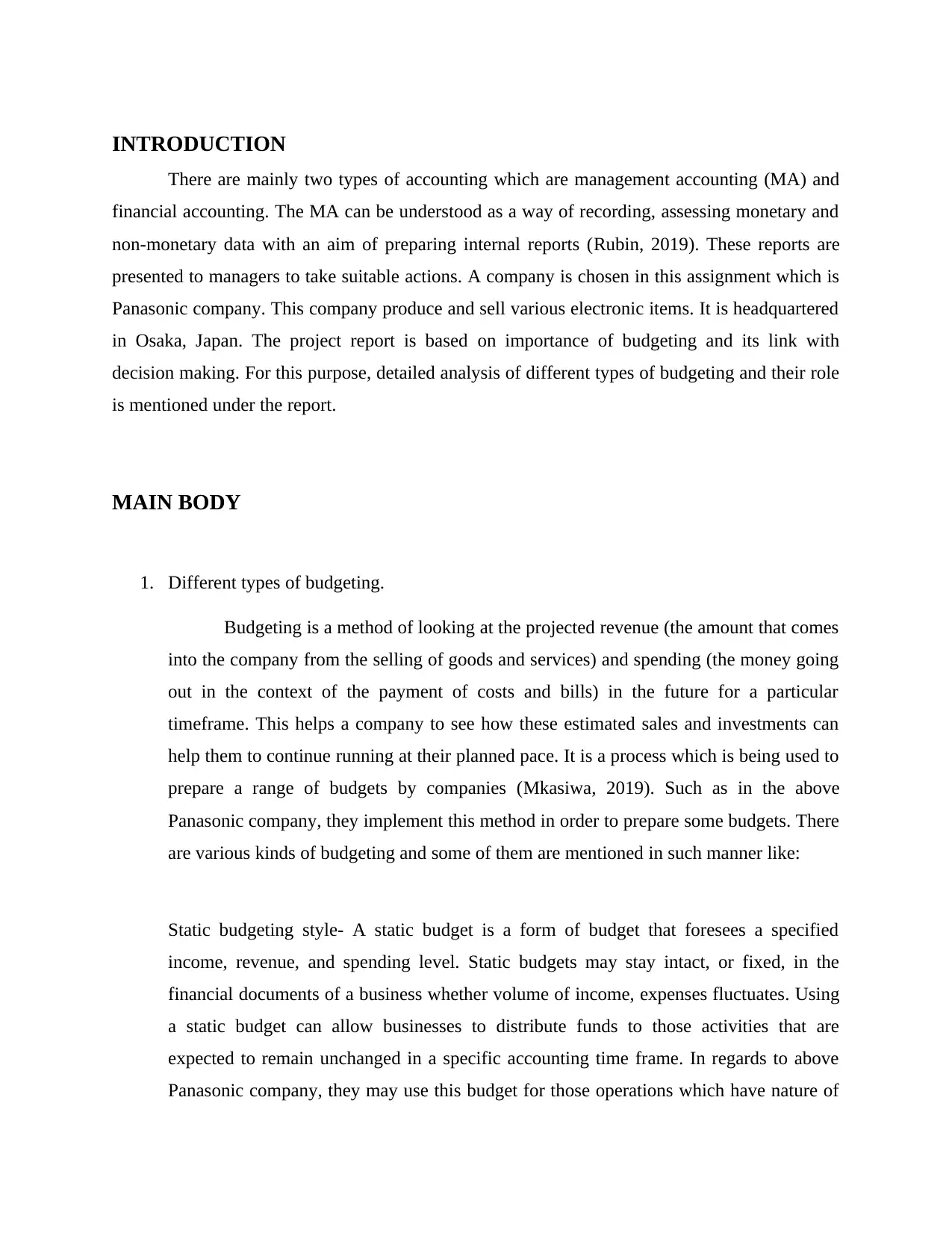
INTRODUCTION
There are mainly two types of accounting which are management accounting (MA) and
financial accounting. The MA can be understood as a way of recording, assessing monetary and
non-monetary data with an aim of preparing internal reports (Rubin, 2019). These reports are
presented to managers to take suitable actions. A company is chosen in this assignment which is
Panasonic company. This company produce and sell various electronic items. It is headquartered
in Osaka, Japan. The project report is based on importance of budgeting and its link with
decision making. For this purpose, detailed analysis of different types of budgeting and their role
is mentioned under the report.
MAIN BODY
1. Different types of budgeting.
Budgeting is a method of looking at the projected revenue (the amount that comes
into the company from the selling of goods and services) and spending (the money going
out in the context of the payment of costs and bills) in the future for a particular
timeframe. This helps a company to see how these estimated sales and investments can
help them to continue running at their planned pace. It is a process which is being used to
prepare a range of budgets by companies (Mkasiwa, 2019). Such as in the above
Panasonic company, they implement this method in order to prepare some budgets. There
are various kinds of budgeting and some of them are mentioned in such manner like:
Static budgeting style- A static budget is a form of budget that foresees a specified
income, revenue, and spending level. Static budgets may stay intact, or fixed, in the
financial documents of a business whether volume of income, expenses fluctuates. Using
a static budget can allow businesses to distribute funds to those activities that are
expected to remain unchanged in a specific accounting time frame. In regards to above
Panasonic company, they may use this budget for those operations which have nature of
There are mainly two types of accounting which are management accounting (MA) and
financial accounting. The MA can be understood as a way of recording, assessing monetary and
non-monetary data with an aim of preparing internal reports (Rubin, 2019). These reports are
presented to managers to take suitable actions. A company is chosen in this assignment which is
Panasonic company. This company produce and sell various electronic items. It is headquartered
in Osaka, Japan. The project report is based on importance of budgeting and its link with
decision making. For this purpose, detailed analysis of different types of budgeting and their role
is mentioned under the report.
MAIN BODY
1. Different types of budgeting.
Budgeting is a method of looking at the projected revenue (the amount that comes
into the company from the selling of goods and services) and spending (the money going
out in the context of the payment of costs and bills) in the future for a particular
timeframe. This helps a company to see how these estimated sales and investments can
help them to continue running at their planned pace. It is a process which is being used to
prepare a range of budgets by companies (Mkasiwa, 2019). Such as in the above
Panasonic company, they implement this method in order to prepare some budgets. There
are various kinds of budgeting and some of them are mentioned in such manner like:
Static budgeting style- A static budget is a form of budget that foresees a specified
income, revenue, and spending level. Static budgets may stay intact, or fixed, in the
financial documents of a business whether volume of income, expenses fluctuates. Using
a static budget can allow businesses to distribute funds to those activities that are
expected to remain unchanged in a specific accounting time frame. In regards to above
Panasonic company, they may use this budget for those operations which have nature of
⊘ This is a preview!⊘
Do you want full access?
Subscribe today to unlock all pages.

Trusted by 1+ million students worldwide
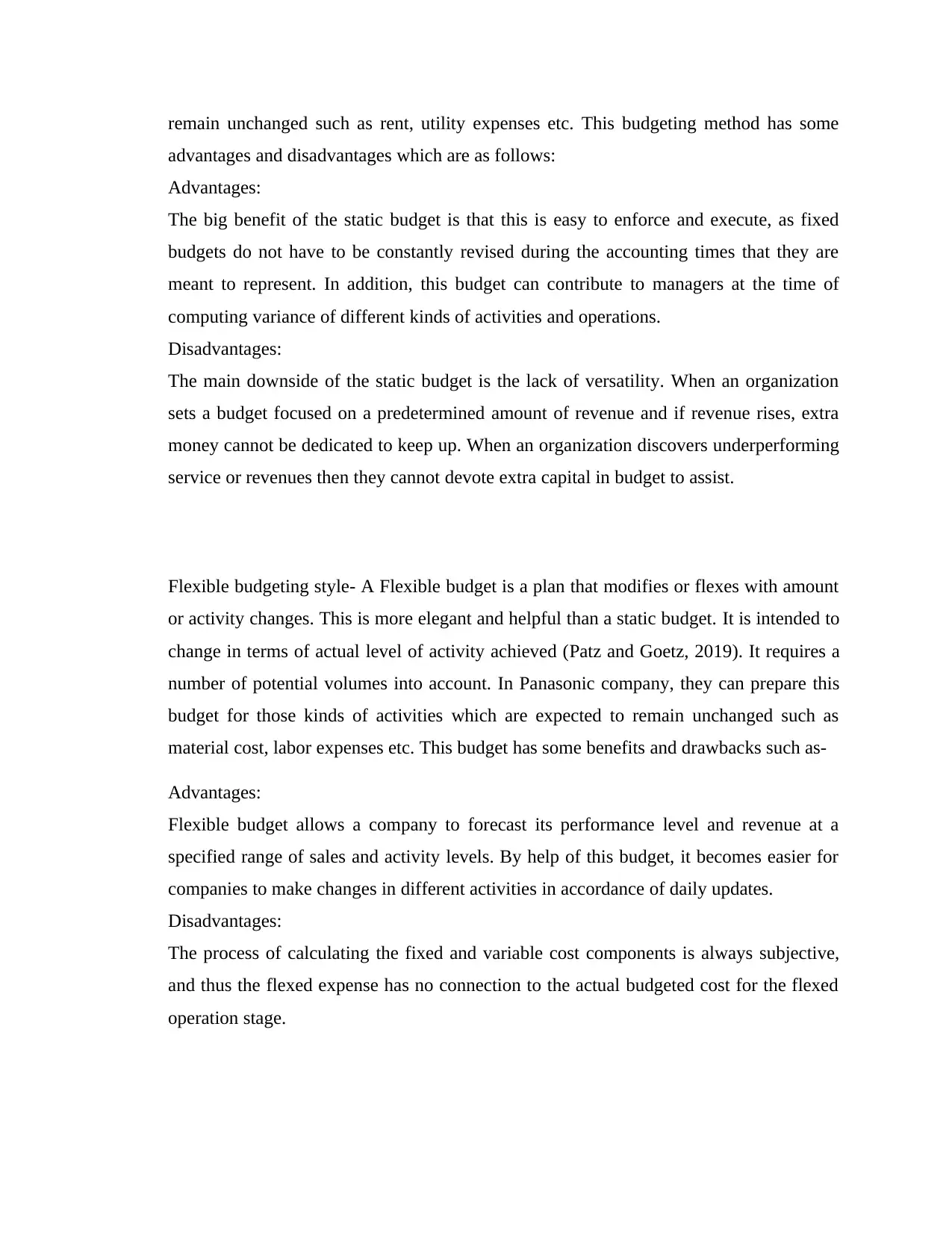
remain unchanged such as rent, utility expenses etc. This budgeting method has some
advantages and disadvantages which are as follows:
Advantages:
The big benefit of the static budget is that this is easy to enforce and execute, as fixed
budgets do not have to be constantly revised during the accounting times that they are
meant to represent. In addition, this budget can contribute to managers at the time of
computing variance of different kinds of activities and operations.
Disadvantages:
The main downside of the static budget is the lack of versatility. When an organization
sets a budget focused on a predetermined amount of revenue and if revenue rises, extra
money cannot be dedicated to keep up. When an organization discovers underperforming
service or revenues then they cannot devote extra capital in budget to assist.
Flexible budgeting style- A Flexible budget is a plan that modifies or flexes with amount
or activity changes. This is more elegant and helpful than a static budget. It is intended to
change in terms of actual level of activity achieved (Patz and Goetz, 2019). It requires a
number of potential volumes into account. In Panasonic company, they can prepare this
budget for those kinds of activities which are expected to remain unchanged such as
material cost, labor expenses etc. This budget has some benefits and drawbacks such as-
Advantages:
Flexible budget allows a company to forecast its performance level and revenue at a
specified range of sales and activity levels. By help of this budget, it becomes easier for
companies to make changes in different activities in accordance of daily updates.
Disadvantages:
The process of calculating the fixed and variable cost components is always subjective,
and thus the flexed expense has no connection to the actual budgeted cost for the flexed
operation stage.
advantages and disadvantages which are as follows:
Advantages:
The big benefit of the static budget is that this is easy to enforce and execute, as fixed
budgets do not have to be constantly revised during the accounting times that they are
meant to represent. In addition, this budget can contribute to managers at the time of
computing variance of different kinds of activities and operations.
Disadvantages:
The main downside of the static budget is the lack of versatility. When an organization
sets a budget focused on a predetermined amount of revenue and if revenue rises, extra
money cannot be dedicated to keep up. When an organization discovers underperforming
service or revenues then they cannot devote extra capital in budget to assist.
Flexible budgeting style- A Flexible budget is a plan that modifies or flexes with amount
or activity changes. This is more elegant and helpful than a static budget. It is intended to
change in terms of actual level of activity achieved (Patz and Goetz, 2019). It requires a
number of potential volumes into account. In Panasonic company, they can prepare this
budget for those kinds of activities which are expected to remain unchanged such as
material cost, labor expenses etc. This budget has some benefits and drawbacks such as-
Advantages:
Flexible budget allows a company to forecast its performance level and revenue at a
specified range of sales and activity levels. By help of this budget, it becomes easier for
companies to make changes in different activities in accordance of daily updates.
Disadvantages:
The process of calculating the fixed and variable cost components is always subjective,
and thus the flexed expense has no connection to the actual budgeted cost for the flexed
operation stage.
Paraphrase This Document
Need a fresh take? Get an instant paraphrase of this document with our AI Paraphraser
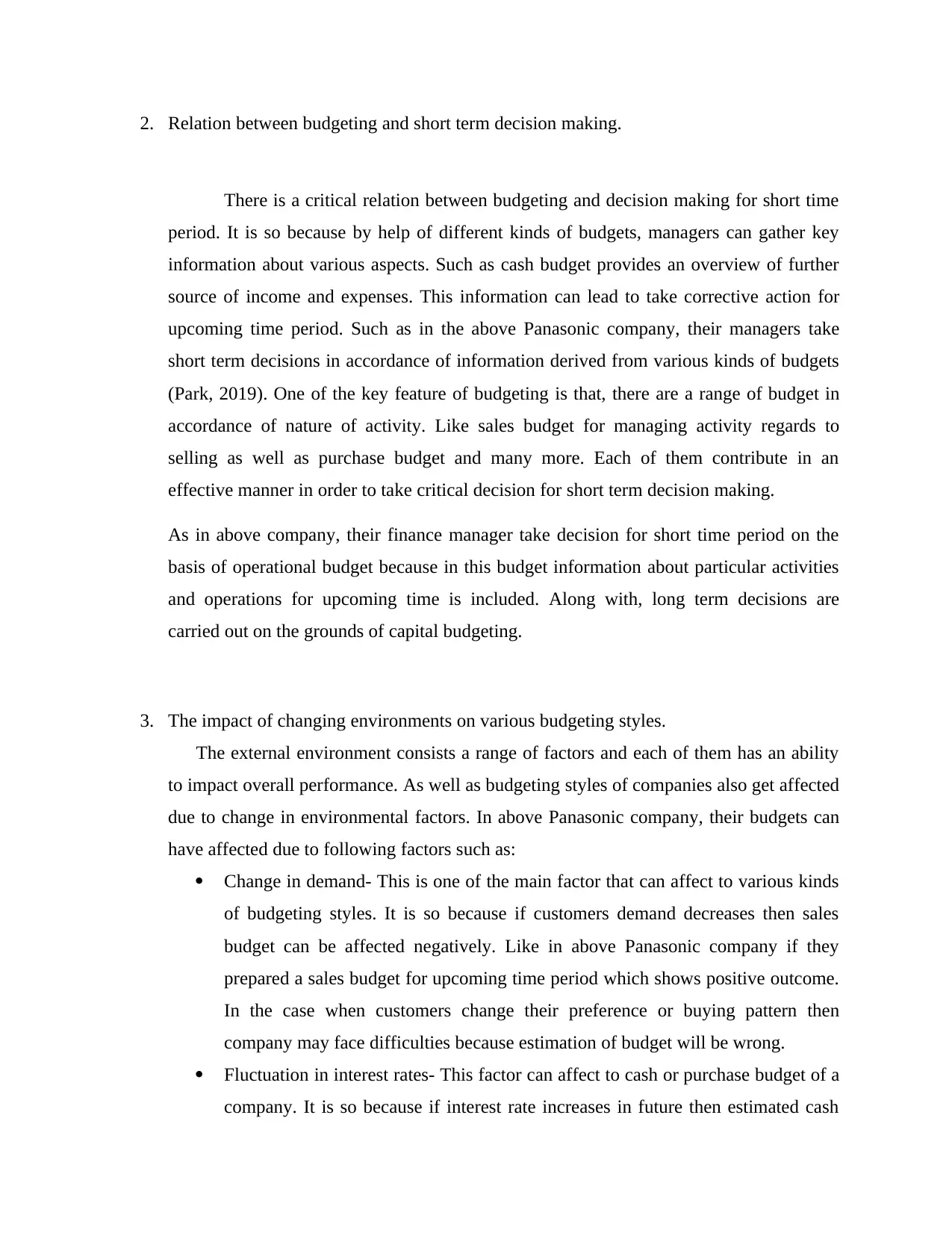
2. Relation between budgeting and short term decision making.
There is a critical relation between budgeting and decision making for short time
period. It is so because by help of different kinds of budgets, managers can gather key
information about various aspects. Such as cash budget provides an overview of further
source of income and expenses. This information can lead to take corrective action for
upcoming time period. Such as in the above Panasonic company, their managers take
short term decisions in accordance of information derived from various kinds of budgets
(Park, 2019). One of the key feature of budgeting is that, there are a range of budget in
accordance of nature of activity. Like sales budget for managing activity regards to
selling as well as purchase budget and many more. Each of them contribute in an
effective manner in order to take critical decision for short term decision making.
As in above company, their finance manager take decision for short time period on the
basis of operational budget because in this budget information about particular activities
and operations for upcoming time is included. Along with, long term decisions are
carried out on the grounds of capital budgeting.
3. The impact of changing environments on various budgeting styles.
The external environment consists a range of factors and each of them has an ability
to impact overall performance. As well as budgeting styles of companies also get affected
due to change in environmental factors. In above Panasonic company, their budgets can
have affected due to following factors such as:
Change in demand- This is one of the main factor that can affect to various kinds
of budgeting styles. It is so because if customers demand decreases then sales
budget can be affected negatively. Like in above Panasonic company if they
prepared a sales budget for upcoming time period which shows positive outcome.
In the case when customers change their preference or buying pattern then
company may face difficulties because estimation of budget will be wrong.
Fluctuation in interest rates- This factor can affect to cash or purchase budget of a
company. It is so because if interest rate increases in future then estimated cash
There is a critical relation between budgeting and decision making for short time
period. It is so because by help of different kinds of budgets, managers can gather key
information about various aspects. Such as cash budget provides an overview of further
source of income and expenses. This information can lead to take corrective action for
upcoming time period. Such as in the above Panasonic company, their managers take
short term decisions in accordance of information derived from various kinds of budgets
(Park, 2019). One of the key feature of budgeting is that, there are a range of budget in
accordance of nature of activity. Like sales budget for managing activity regards to
selling as well as purchase budget and many more. Each of them contribute in an
effective manner in order to take critical decision for short term decision making.
As in above company, their finance manager take decision for short time period on the
basis of operational budget because in this budget information about particular activities
and operations for upcoming time is included. Along with, long term decisions are
carried out on the grounds of capital budgeting.
3. The impact of changing environments on various budgeting styles.
The external environment consists a range of factors and each of them has an ability
to impact overall performance. As well as budgeting styles of companies also get affected
due to change in environmental factors. In above Panasonic company, their budgets can
have affected due to following factors such as:
Change in demand- This is one of the main factor that can affect to various kinds
of budgeting styles. It is so because if customers demand decreases then sales
budget can be affected negatively. Like in above Panasonic company if they
prepared a sales budget for upcoming time period which shows positive outcome.
In the case when customers change their preference or buying pattern then
company may face difficulties because estimation of budget will be wrong.
Fluctuation in interest rates- This factor can affect to cash or purchase budget of a
company. It is so because if interest rate increases in future then estimated cash
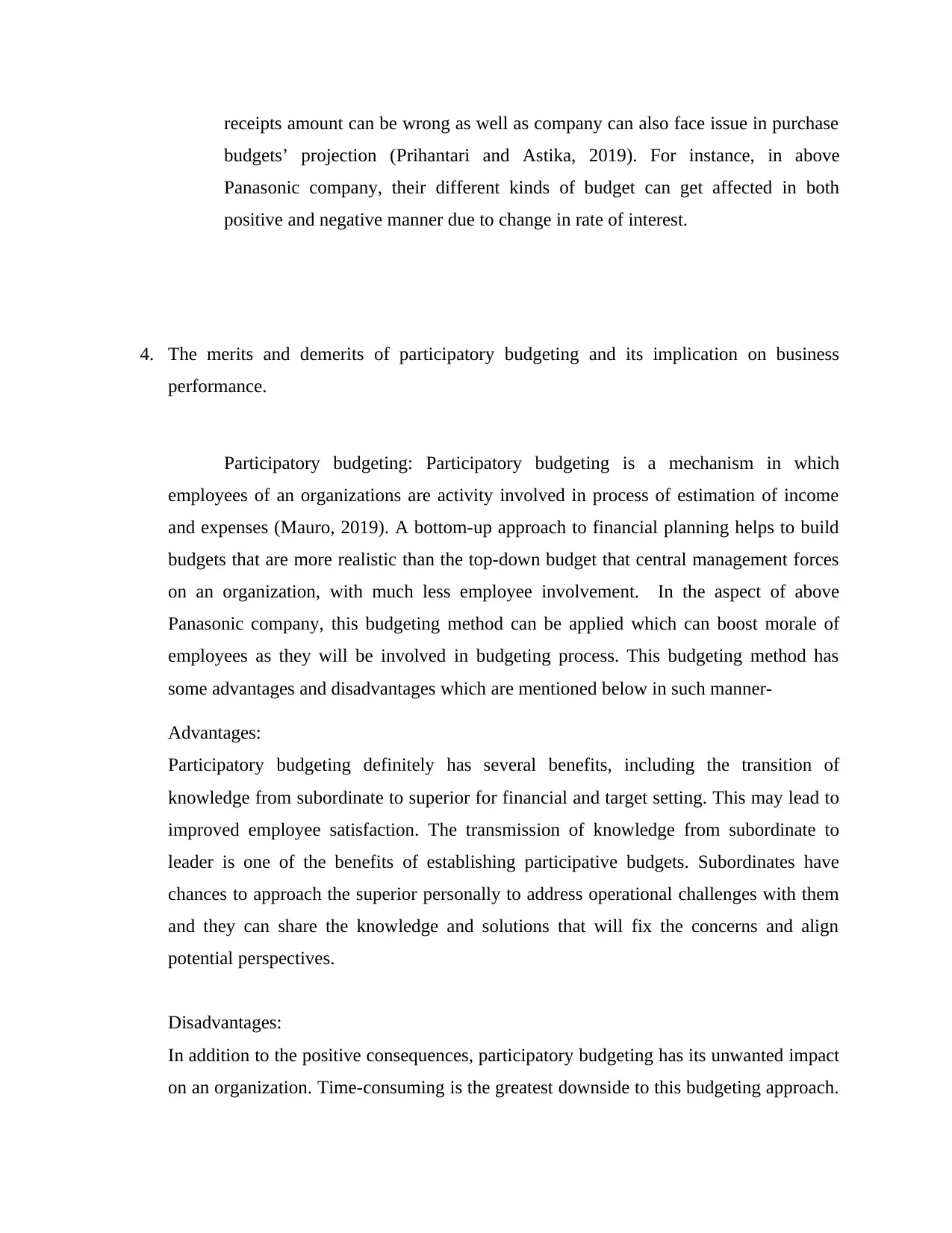
receipts amount can be wrong as well as company can also face issue in purchase
budgets’ projection (Prihantari and Astika, 2019). For instance, in above
Panasonic company, their different kinds of budget can get affected in both
positive and negative manner due to change in rate of interest.
4. The merits and demerits of participatory budgeting and its implication on business
performance.
Participatory budgeting: Participatory budgeting is a mechanism in which
employees of an organizations are activity involved in process of estimation of income
and expenses (Mauro, 2019). A bottom-up approach to financial planning helps to build
budgets that are more realistic than the top-down budget that central management forces
on an organization, with much less employee involvement. In the aspect of above
Panasonic company, this budgeting method can be applied which can boost morale of
employees as they will be involved in budgeting process. This budgeting method has
some advantages and disadvantages which are mentioned below in such manner-
Advantages:
Participatory budgeting definitely has several benefits, including the transition of
knowledge from subordinate to superior for financial and target setting. This may lead to
improved employee satisfaction. The transmission of knowledge from subordinate to
leader is one of the benefits of establishing participative budgets. Subordinates have
chances to approach the superior personally to address operational challenges with them
and they can share the knowledge and solutions that will fix the concerns and align
potential perspectives.
Disadvantages:
In addition to the positive consequences, participatory budgeting has its unwanted impact
on an organization. Time-consuming is the greatest downside to this budgeting approach.
budgets’ projection (Prihantari and Astika, 2019). For instance, in above
Panasonic company, their different kinds of budget can get affected in both
positive and negative manner due to change in rate of interest.
4. The merits and demerits of participatory budgeting and its implication on business
performance.
Participatory budgeting: Participatory budgeting is a mechanism in which
employees of an organizations are activity involved in process of estimation of income
and expenses (Mauro, 2019). A bottom-up approach to financial planning helps to build
budgets that are more realistic than the top-down budget that central management forces
on an organization, with much less employee involvement. In the aspect of above
Panasonic company, this budgeting method can be applied which can boost morale of
employees as they will be involved in budgeting process. This budgeting method has
some advantages and disadvantages which are mentioned below in such manner-
Advantages:
Participatory budgeting definitely has several benefits, including the transition of
knowledge from subordinate to superior for financial and target setting. This may lead to
improved employee satisfaction. The transmission of knowledge from subordinate to
leader is one of the benefits of establishing participative budgets. Subordinates have
chances to approach the superior personally to address operational challenges with them
and they can share the knowledge and solutions that will fix the concerns and align
potential perspectives.
Disadvantages:
In addition to the positive consequences, participatory budgeting has its unwanted impact
on an organization. Time-consuming is the greatest downside to this budgeting approach.
⊘ This is a preview!⊘
Do you want full access?
Subscribe today to unlock all pages.

Trusted by 1+ million students worldwide
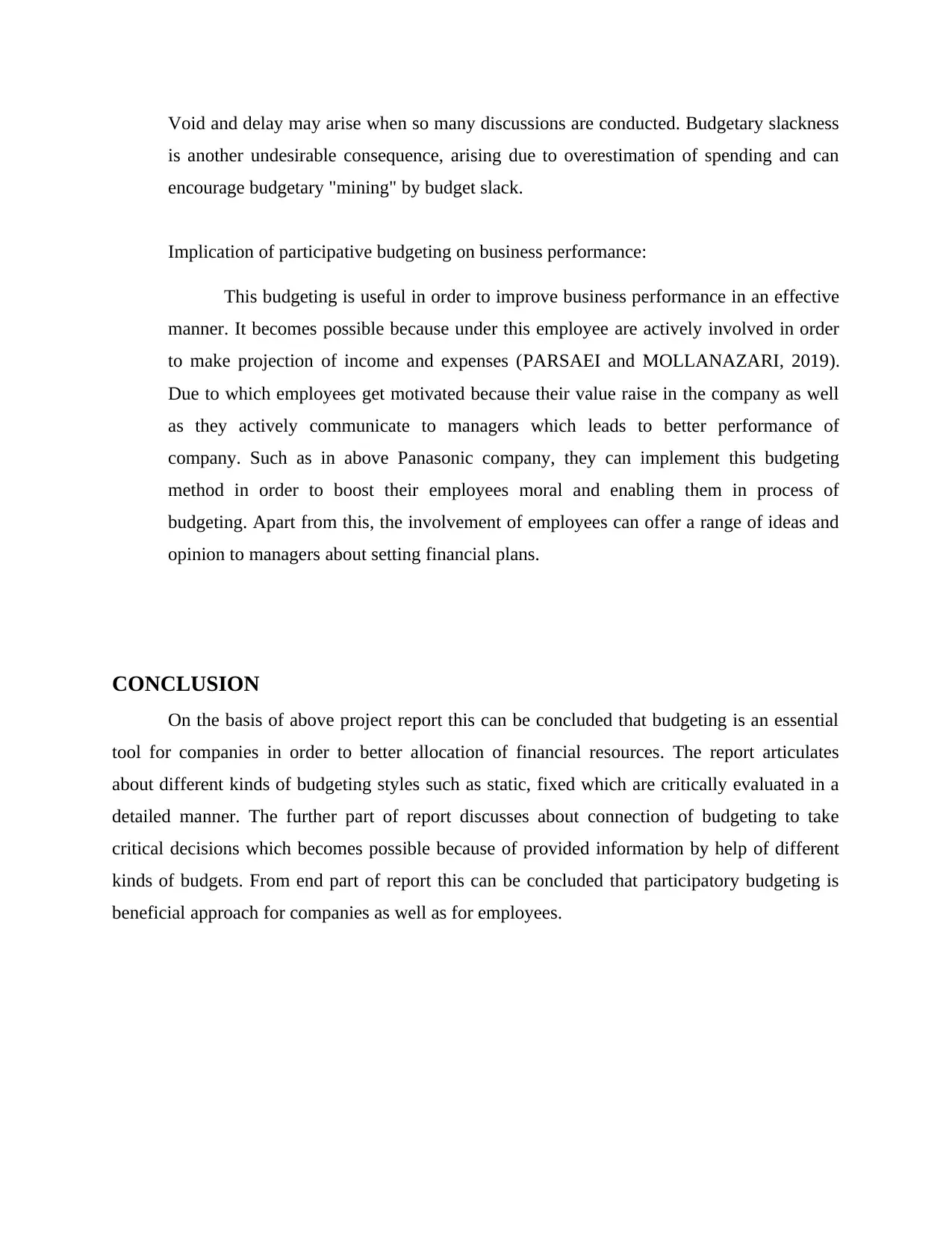
Void and delay may arise when so many discussions are conducted. Budgetary slackness
is another undesirable consequence, arising due to overestimation of spending and can
encourage budgetary "mining" by budget slack.
Implication of participative budgeting on business performance:
This budgeting is useful in order to improve business performance in an effective
manner. It becomes possible because under this employee are actively involved in order
to make projection of income and expenses (PARSAEI and MOLLANAZARI, 2019).
Due to which employees get motivated because their value raise in the company as well
as they actively communicate to managers which leads to better performance of
company. Such as in above Panasonic company, they can implement this budgeting
method in order to boost their employees moral and enabling them in process of
budgeting. Apart from this, the involvement of employees can offer a range of ideas and
opinion to managers about setting financial plans.
CONCLUSION
On the basis of above project report this can be concluded that budgeting is an essential
tool for companies in order to better allocation of financial resources. The report articulates
about different kinds of budgeting styles such as static, fixed which are critically evaluated in a
detailed manner. The further part of report discusses about connection of budgeting to take
critical decisions which becomes possible because of provided information by help of different
kinds of budgets. From end part of report this can be concluded that participatory budgeting is
beneficial approach for companies as well as for employees.
is another undesirable consequence, arising due to overestimation of spending and can
encourage budgetary "mining" by budget slack.
Implication of participative budgeting on business performance:
This budgeting is useful in order to improve business performance in an effective
manner. It becomes possible because under this employee are actively involved in order
to make projection of income and expenses (PARSAEI and MOLLANAZARI, 2019).
Due to which employees get motivated because their value raise in the company as well
as they actively communicate to managers which leads to better performance of
company. Such as in above Panasonic company, they can implement this budgeting
method in order to boost their employees moral and enabling them in process of
budgeting. Apart from this, the involvement of employees can offer a range of ideas and
opinion to managers about setting financial plans.
CONCLUSION
On the basis of above project report this can be concluded that budgeting is an essential
tool for companies in order to better allocation of financial resources. The report articulates
about different kinds of budgeting styles such as static, fixed which are critically evaluated in a
detailed manner. The further part of report discusses about connection of budgeting to take
critical decisions which becomes possible because of provided information by help of different
kinds of budgets. From end part of report this can be concluded that participatory budgeting is
beneficial approach for companies as well as for employees.
Paraphrase This Document
Need a fresh take? Get an instant paraphrase of this document with our AI Paraphraser
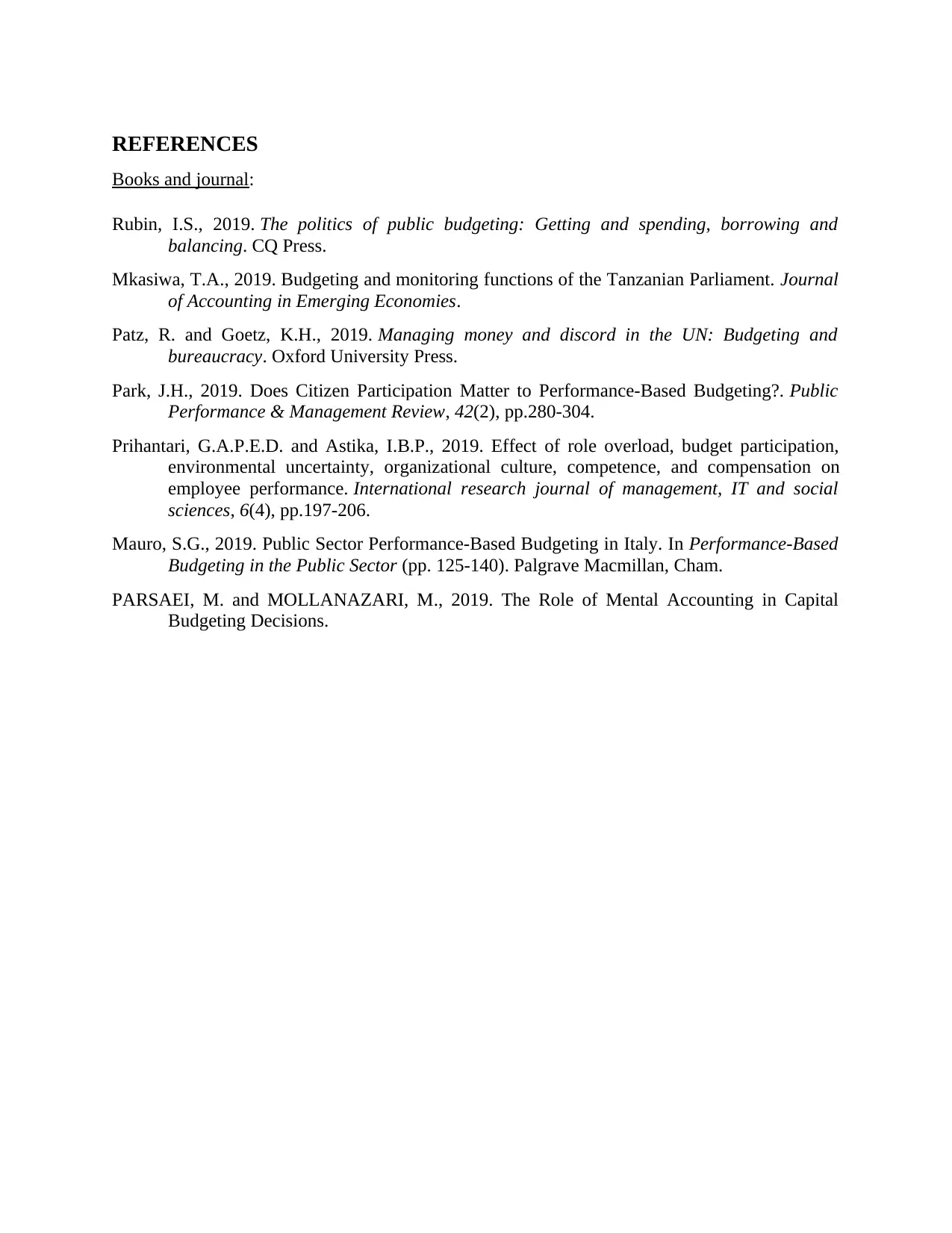
REFERENCES
Books and journal:
Rubin, I.S., 2019. The politics of public budgeting: Getting and spending, borrowing and
balancing. CQ Press.
Mkasiwa, T.A., 2019. Budgeting and monitoring functions of the Tanzanian Parliament. Journal
of Accounting in Emerging Economies.
Patz, R. and Goetz, K.H., 2019. Managing money and discord in the UN: Budgeting and
bureaucracy. Oxford University Press.
Park, J.H., 2019. Does Citizen Participation Matter to Performance-Based Budgeting?. Public
Performance & Management Review, 42(2), pp.280-304.
Prihantari, G.A.P.E.D. and Astika, I.B.P., 2019. Effect of role overload, budget participation,
environmental uncertainty, organizational culture, competence, and compensation on
employee performance. International research journal of management, IT and social
sciences, 6(4), pp.197-206.
Mauro, S.G., 2019. Public Sector Performance-Based Budgeting in Italy. In Performance-Based
Budgeting in the Public Sector (pp. 125-140). Palgrave Macmillan, Cham.
PARSAEI, M. and MOLLANAZARI, M., 2019. The Role of Mental Accounting in Capital
Budgeting Decisions.
Books and journal:
Rubin, I.S., 2019. The politics of public budgeting: Getting and spending, borrowing and
balancing. CQ Press.
Mkasiwa, T.A., 2019. Budgeting and monitoring functions of the Tanzanian Parliament. Journal
of Accounting in Emerging Economies.
Patz, R. and Goetz, K.H., 2019. Managing money and discord in the UN: Budgeting and
bureaucracy. Oxford University Press.
Park, J.H., 2019. Does Citizen Participation Matter to Performance-Based Budgeting?. Public
Performance & Management Review, 42(2), pp.280-304.
Prihantari, G.A.P.E.D. and Astika, I.B.P., 2019. Effect of role overload, budget participation,
environmental uncertainty, organizational culture, competence, and compensation on
employee performance. International research journal of management, IT and social
sciences, 6(4), pp.197-206.
Mauro, S.G., 2019. Public Sector Performance-Based Budgeting in Italy. In Performance-Based
Budgeting in the Public Sector (pp. 125-140). Palgrave Macmillan, Cham.
PARSAEI, M. and MOLLANAZARI, M., 2019. The Role of Mental Accounting in Capital
Budgeting Decisions.
1 out of 8
Related Documents
Your All-in-One AI-Powered Toolkit for Academic Success.
+13062052269
info@desklib.com
Available 24*7 on WhatsApp / Email
![[object Object]](/_next/static/media/star-bottom.7253800d.svg)
Unlock your academic potential
Copyright © 2020–2025 A2Z Services. All Rights Reserved. Developed and managed by ZUCOL.





